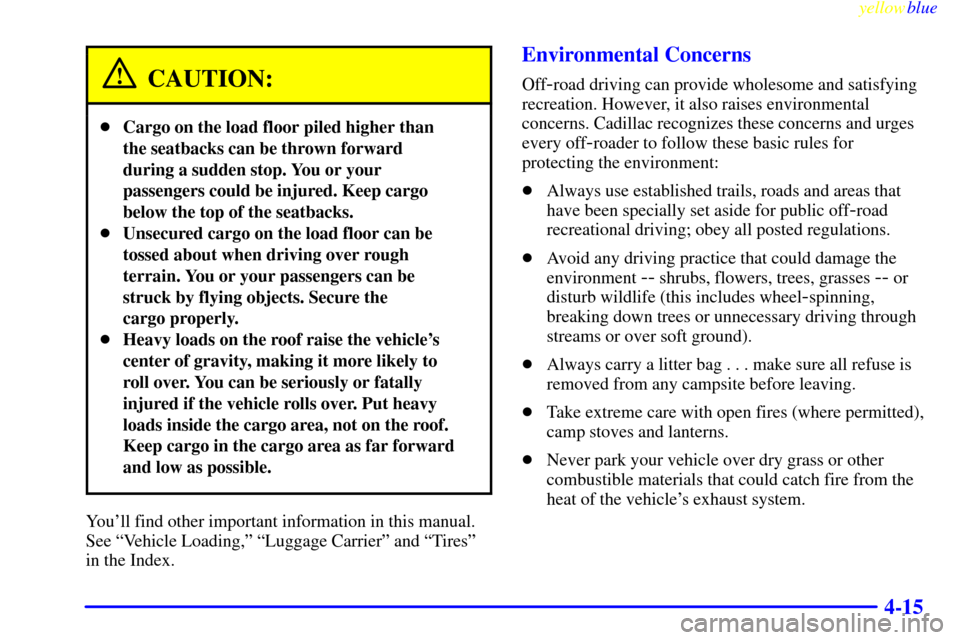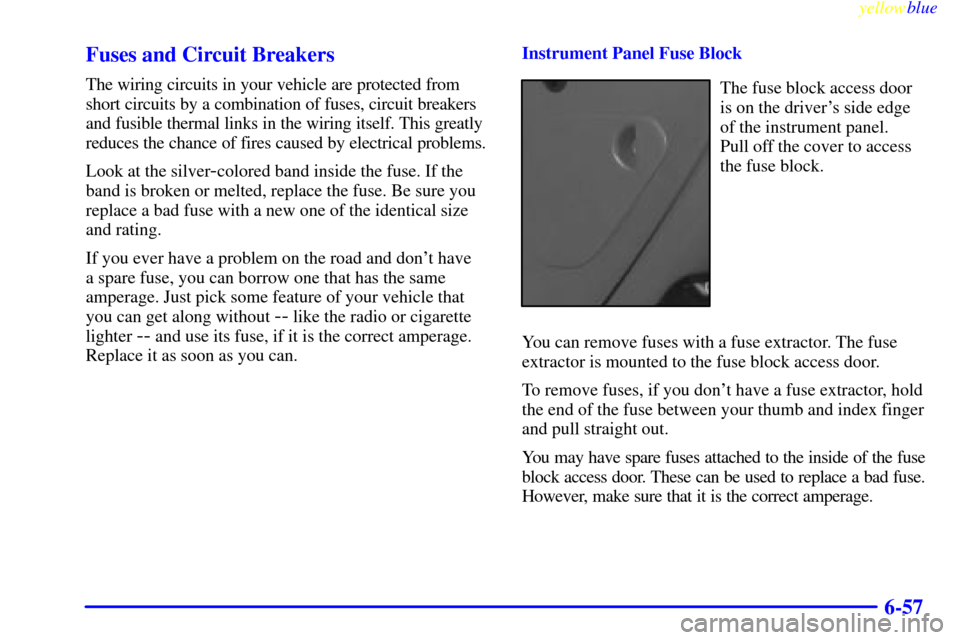Page 133 of 352
yellowblue
2-69
A. Dome Override Switch
B. Lamp Controls
C. Air Outlets
D. Multifunction Lever
E. Instrument Panel Cluster
F. Gearshift Lever
G. Rear Window Wiper Washer Switch (If Equipped)
H. Audio System
I. Comfort Control System
J. Glove Box
K. AshtrayL. Cupholder
M. Auxiliary Power Outlets
N. Compact Disc Player
O. Electric Tailgate Glass Release (If Equipped)
P. Fog Lamp Switch
Q. Automatic Transfer Case Switch
R. Tilt Lever
S. Parking Brake Release
T. Hood Release
U. Fuse Block
Page 187 of 352

yellowblue
4-15
CAUTION:
�Cargo on the load floor piled higher than
the seatbacks can be thrown forward
during a sudden stop. You or your
passengers could be injured. Keep cargo
below the top of the seatbacks.
�Unsecured cargo on the load floor can be
tossed about when driving over rough
terrain. You or your passengers can be
struck by flying objects. Secure the
cargo properly.
�Heavy loads on the roof raise the vehicle's
center of gravity, making it more likely to
roll over. You can be seriously or fatally
injured if the vehicle rolls over. Put heavy
loads inside the cargo area, not on the roof.
Keep cargo in the cargo area as far forward
and low as possible.
You'll find other important information in this manual.
See ªVehicle Loading,º ªLuggage Carrierº and ªTiresº
in the Index.
Environmental Concerns
Off-road driving can provide wholesome and satisfying
recreation. However, it also raises environmental
concerns. Cadillac recognizes these concerns and urges
every off
-roader to follow these basic rules for
protecting the environment:
�Always use established trails, roads and areas that
have been specially set aside for public off
-road
recreational driving; obey all posted regulations.
�Avoid any driving practice that could damage the
environment
-- shrubs, flowers, trees, grasses -- or
disturb wildlife (this includes wheel
-spinning,
breaking down trees or unnecessary driving through
streams or over soft ground).
�Always carry a litter bag . . . make sure all refuse is
removed from any campsite before leaving.
�Take extreme care with open fires (where permitted),
camp stoves and lanterns.
�Never park your vehicle over dry grass or other
combustible materials that could catch fire from the
heat of the vehicle's exhaust system.
Page 225 of 352

yellowblue
4-53
An eight-wire harness is stored under the rear bumper of
your vehicle. The five
-wire light-duty harness is located
at the left rear inner lower quarter panel. The additional
heavy
-duty wiring is located forward of the rear bumper
and is attached to the center of the rear crossmember or
the forward vertical surface of the platform hitch.
This harness has a 30 amp battery feed wire and no
connector, and should be wired by a qualified electrical
technician. After choosing an aftermarket mating
connector pair, have the technician attach one connector
to the eight
-wire trailer harness and the other connector
to the wiring harness on the trailer. Be sure that the
wiring harness on the trailer is strapped to the trailer's
frame and leave it loose enough so that the wiring
doesn't bend or break, but not so loose that it drags on
the ground. The technician can use the following color
code chart when connecting the wiring harness to
your trailer.�Brown: Rear Lamps
�Yellow: Left Stoplamp and Turn Signal
�Dark Green: Right Stoplamp and Turn Signal
�White (Heavy Gauge): Ground
�Light Green: Back
-up Lamps
�White (Light Gauge): Center High
-Mounted
Stop Lamp
�Blue: Auxiliary/Electric Trailer Brake Circuit
�Orange: Fused Auxiliary Circuit
Store the harness in its original place. Wrap the harness
together and tie it neatly so it won't be damaged.
Page 263 of 352

yellowblue
6-3
CAUTION:
You can be injured and your vehicle could be
damaged if you try to do service work on a
vehicle without knowing enough about it.
�Be sure you have sufficient knowledge,
experience, the proper replacement parts
and tools before you attempt any vehicle
maintenance task.
�Be sure to use the proper nuts, bolts and
other fasteners. ªEnglishº and ªmetricº
fasteners can be easily confused. If you use
the wrong fasteners, parts can later break
or fall off. You could be hurt.
Adding Equipment to the Outside of
Your Vehicle
Things you might add to the outside of your vehicle can
affect the airflow around it. This may cause wind noise
and affect windshield washer performance. Check with
your dealer before adding equipment to the outside of
your vehicle.
Fuel
Use regular unleaded gasoline rated at 87 octane or
higher. It is recommended that the gasoline meet
specifications which have been developed by the
American Automobile Manufacturers Association
(AAMA) and endorsed by the Canadian Motor
Vehicle Manufacturers Association for better vehicle
performance and engine protection. Gasolines meeting
the AAMA specification could provide improved
driveability and emission control system performance
compared to other gasolines. For more information,
write to: American Automobile Manufacturer's
Association, 7430 Second Ave, Suite 300,
Detroit MI 48202.
Be sure the posted octane is at least 87. If the octane is
less than 87, you may get a heavy knocking noise when
you drive. If it's bad enough, it can damage your engine.
If you're using fuel rated at 87 octane or higher and you
hear heavy knocking, your engine needs service. But
don't worry if you hear a little pinging noise when
you're accelerating or driving up a hill. That's normal,
and you don't have to buy a higher octane fuel to get rid
of pinging. It's the heavy, constant knock that means
you have a problem.
Page 270 of 352
yellowblue
6-10
ªVORTECº 5700 V8 Engine
When you lift up the hood you'll see:
A. Battery
B. Coolant Recovery Tank
C. Radiator Pressure Cap
D. Engine Air Cleaner/Filter
E. Air Filter Restriction IndicatorF. Engine Oil Dipstick
G. Automatic Transmission Dipstick
H. Engine Cooling Fan
I. Engine Oil FillJ. Power Steering Fluid Reservoir
K. Brake Fluid Reservoir
L. Windshield Washer
Fluid Reservoir
M. Underhood Fuse/Relay Center
Page 316 of 352

yellowblue
6-56
Electrical System
Add-On Electrical Equipment
NOTICE:
Don't add anything electrical to your vehicle unless
you check with your dealer first. Some electrical
equipment can damage your vehicle and the
damage wouldn't be covered by your warranty.
Some add
-on electrical equipment can keep other
components from working as they should.
Your vehicle has an air bag system. Before attempting to
add anything electrical to your vehicle, see ªServicing
Your Air Bag
-Equipped Vehicleº in the Index.
Headlamp Wiring
The headlamp wiring is protected by a circuit breaker in
the lamp switch. An electrical overload will cause the
lamps to flicker on and off, or in some cases to remain
off. If this happens, have your headlamp wiring checked
right away.
Windshield Wipers
The windshield wiper motor is protected by a circuit
breaker and a fuse. If the motor overheats due to heavy
snow, etc., the wiper will stop until the motor cools.
Although the circuit is protected from electrical
overload, overload due to heavy snow, etc., may cause
wiper linkage damage. Always clear ice and heavy snow
from the windshield before using the windshield wipers.
If the overload is caused by some electrical problem and
not snow, etc., be sure to get it fixed.
Power Windows and Other Power Options
Circuit breakers in the fuse panel protect the power
windows and other power accessories. When the current
load is too heavy, the circuit breaker opens and closes.
This protects the circuit until the current load returns to
normal or the problem is fixed.
Page 317 of 352

yellowblue
6-57 Fuses and Circuit Breakers
The wiring circuits in your vehicle are protected from
short circuits by a combination of fuses, circuit breakers
and fusible thermal links in the wiring itself. This greatly
reduces the chance of fires caused by electrical problems.
Look at the silver
-colored band inside the fuse. If the
band is broken or melted, replace the fuse. Be sure you
replace a bad fuse with a new one of the identical size
and rating.
If you ever have a problem on the road and don't have
a spare fuse, you can borrow one that has the same
amperage. Just pick some feature of your vehicle that
you can get along without
-- like the radio or cigarette
lighter
-- and use its fuse, if it is the correct amperage.
Replace it as soon as you can.Instrument Panel Fuse Block
The fuse block access door
is on the driver's side edge
of the instrument panel.
Pull off the cover to access
the fuse block.
You can remove fuses with a fuse extractor. The fuse
extractor is mounted to the fuse block access door.
To remove fuses, if you don't have a fuse extractor, hold
the end of the fuse between your thumb and index finger
and pull straight out.
You may have spare fuses attached to the inside of the fuse
block access door. These can be used to replace a bad fuse.
However, make sure that it is the correct amperage.
Page 318 of 352
yellowblue
6-58
Fuse/Circuit
BreakerUsage
1 Stop/TCC Switch, Buzzer, CHMSL,
Hazard Lamps, Stoplamps
2 Transfer CaseFuse/Circuit
BreakerUsage
3 Courtesy Lamps, Cargo Lamp,
Glove Box Lamp, Dome/Reading
Lamps, Vanity Mirrors,
Power Mirrors
4 Instrument Cluster, DRL Relay,
Lamp Switch, Keyless Entry,
Low Coolant Module, Illuminated
Entry Module
5 Rear Comfort Controls
6 Cruise Control
7 Auxiliary Power Outlet
8 Crank
9 License Lamp, Parking Lamps,
Taillamps, Tailgate Lamps, Front
Sidemarkers, Fog Lamp Relay,
Door Switch Illumination,
Fender Lamps, Headlamp
Switch Illumination
10 Air Bag System
11 Wiper Motor, Washer Pump
12 A/C, A/C Blower,
High Blower Relay